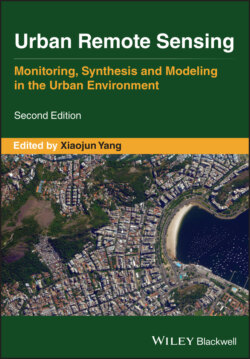Читать книгу Urban Remote Sensing - Группа авторов - Страница 21
1.3.2 ALGORITHMS AND TECHNIQUES FOR URBAN ATTRIBUTE EXTRACTION
ОглавлениеWith four major chapters, this part (Part III) discusses several emerging remote sensing and machine learning techniques, such as deep learning and cloud computing infrastructures, for urban attribute extraction. It begins with Chapter 8 discussing deep learning models for urban and landscape mapping from remotely sensed data with the specific attention on deep neural networks such as convolution neural networks (CNNs) and recurrent neural networks (RNNs) in addressing current land classification challenges. Two case studies using CNNs and RNNs for landscape mapping over a complex urbanized coastal area are further presented to demonstrate how deep learning models can be used to generate improved performance in remote sensing.
The other three chapters in this part are concerned with cloud computing infrastructure for large‐scale geospatial data processing and services, image endmember libraries for urban mapping, and multiscale landscape analysis for urban growth monitoring and environmental impact assessment. Chapter 9 introduces the technical and scientific aspects of GEE emerging as a new cloud‐based remote sensing platform for urban and landscape studies. The authors review the use of GEE in several specific areas, such as urban extent mapping, urbanization estimation, urban ecosystem characterization, and city accessibility assessment. They further present two case studies using GEE for urban extent mapping and ecosystem characterization. Chapter 10 focuses on creating generic urban libraries of reference spectral to facilitate the transferability of urban mapping methods. The authors discuss the methods for creating multi‐site reference spectra libraries and for using them to support various urban mapping applications. They introduce the idea of a Generic Urban Library (GUL) that allows to share reference spectra in support of various applications. With specific case studies, they further demonstrate the merits of sharing multi‐site reference spectra using library‐based mapping approaches. The last chapter in this part (Chapter 11) discusses a multi‐faceted approach to address some challenges associated with scale, which includes examining the same geographic area at multiple spatial resolutions and extents based on various satellite imagery, using object‐based image analysis and ecological analysis units to minimize the modifiable area unit problem, and separately examining landscape change on social and ecological scales. By applying the approach to Stockholm, Sweden, the authors conclude that multiscale analysis can not only reveal the broader trends of urbanization and the accompanying environmental impacts but also help identify localized environmental hotspots where mitigation measures can be implemented.
